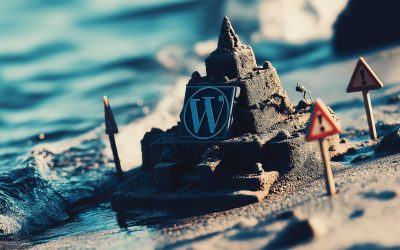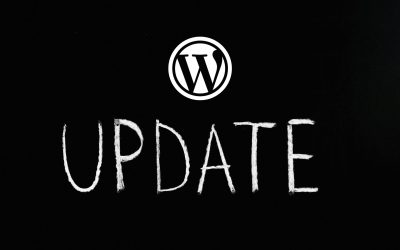WordPress is a popular open-source website builder and content management system that powers more than 43% of all websites on the internet. Understanding how WordPress works behind the scenes is crucial for optimizing performance, security, and customization. In this comprehensive guide, we will explore the technical aspects of WordPress web hosting, including the evolution of WordPress, its open-source nature, and the key files and folders that drive the platform’s functionality.
A visually striking representation of the technical aspects of WordPress hosting, featuring complex server infrastructure and advanced software integrations. Show the system in action, with a focus on speed and reliability. Use vibrant colors to convey the power and efficiency of this cutting-edge technology.
Key Takeaways:
- Choosing the right WordPress hosting provider is essential for optimal performance and security.
- Understanding the WordPress file and folder structure helps with troubleshooting and customization.
- WordPress hooks and actions allow for code customization and plugin development.
- The WordPress core files and database are fundamental to site functionality and content management.
- Consider factors like server performance, security measures, and customer support when selecting a hosting provider.
The WordPress File and Folder Structure
The core of a WordPress site consists of files and folders that work together to power the platform. Understanding the file and folder structure of WordPress is crucial for troubleshooting and making informed decisions about your site.
The WordPress root directory contains essential files and folders such as wp-admin, wp-content, and wp-includes. The wp-admin folder manages the administrative interface of WordPress, while the wp-includes folder houses the core software. It is important to note that modifying core files can lead to site instability, so it is advised to avoid making changes to these files.
The functions.php file can be modified to add custom code and enhance site functionality. The wp-config.php file is responsible for storing database connection information and other configuration settings. Understanding the role of these files and folders is essential for maintaining a stable and secure WordPress site.
The WordPress File and Folder Structure
In order to understand the technical aspects of WordPress web hosting, you must first familiarize yourself with the file and folder structure that powers the platform. The WordPress root directory contains several crucial files and folders that work together to ensure the smooth functioning of your website.
| Folder | Description |
| wp-admin | Manages the administrative interface of WordPress |
| wp-content | Stores themes, plugins, and uploaded media |
| wp-includes | Houses the core software of WordPress |
These folders play a crucial role in the functioning of WordPress, and it’s important to note that modifying core files can lead to site instability. However, you can enhance your site’s functionality by modifying the functions.php file, which allows you to add custom code. The wp-config.php file, on the other hand, stores database connection information and other configuration settings.
By understanding the file and folder structure of WordPress, you’ll be able to troubleshoot issues more effectively and make informed decisions about your site’s customization and optimization.
WordPress Hooks and Actions
WordPress hooks and actions play a crucial role in customizing the functionality of your WordPress site. Hooks allow you to insert custom code at specific points during the WordPress runtime. They provide a way to modify or extend the default behavior of WordPress without modifying the core files.
Actions, on the other hand, enable you to add or modify data without returning any further information. They are typically used to perform tasks, such as saving data to the database or sending an email, after a specific event or trigger occurs.
By utilizing hooks and actions, you can customize the behavior of your WordPress site according to your specific needs. This includes adding new features, modifying existing functionality, and integrating with other systems. It is a powerful tool for code customization, plugin development, and creating a tailored web experience.
The Difference Between Hooks and Actions
Understanding the difference between hooks and actions is essential for effectively customizing your WordPress site. Hooks, also known as filters, allow you to modify or override existing data or functionality. They can be used to alter the output of a function or add additional parameters to a function call.
Actions, on the other hand, are triggers that allow you to perform additional tasks at specific points in the WordPress runtime. They are typically used to perform actions that don’t require any data to be returned, such as sending a notification or updating a database.
| Hook | Action |
| Allows you to modify existing data or functionality | Allows you to perform additional tasks without returning any data |
| Used to alter the output of a function or add parameters to a function call | Used to perform actions that don’t require data to be returned |
| Example: ‘the_content’ filter | Example: ‘wp_login’ action |
Understanding how hooks and actions work and when to use them is essential for customizing your WordPress site effectively. By harnessing their power, you can unlock the full potential of WordPress and create a unique web experience tailored to your needs.
WordPress Core Files and Database
Understanding the core files and database of WordPress is crucial for managing site functionality and content. The core files serve as the foundation of every WordPress site, while the database stores all site content, including posts, pages, user data, and plugin settings. Let’s take a closer look at these key components:
WordPress Core Files
The WordPress core files are responsible for managing the overall functionality of your website. These files include the index.php file, which loads pages and initializes the core files when a request is made, and the wp-config.php file, which contains crucial configuration settings and database connection information. It’s important to note that modifying core files can lead to site instability, so it’s recommended to avoid making changes to these files unless you are an experienced developer.
WordPress Database
The WordPress database is where all your site content is stored. It includes information such as posts, pages, comments, users, and settings. The database is essential for managing and organizing your site’s content. Whenever you create a new post or page, update a plugin setting, or change a user’s information, the changes are stored in the database. Understanding how the database works can help you troubleshoot issues related to content, such as missing posts or incorrect settings.
Managing the Core Files and Database
Proper management of the core files and database is vital for the smooth operation of your WordPress site. It’s essential to keep your core files up to date by regularly updating WordPress to the latest version. Additionally, performing regular backups of your database helps ensure that you can easily restore your site in case of any issues or data loss. If you’re not comfortable managing the core files and database yourself, consider using a managed WordPress hosting service that takes care of these technical aspects for you.
| Core Files | Database |
| index.php | Posts |
| wp-config.php | Pages |
| Comments | |
| Users | |
| Settings |
By understanding the core files and database of WordPress, you’ll be able to effectively manage your site’s functionality and content. Remember to handle core files with caution and regularly backup your database to ensure a smooth and secure website.
WordPress Web Hosting and Performance Optimization
When it comes to WordPress web hosting, finding the best provider is essential for optimal performance, security, and reliability. A fast and secure hosting environment can significantly enhance your website’s speed, user experience, and search engine rankings. Here are some key factors to consider when selecting a WordPress hosting provider:
- Server Performance: Look for a hosting provider with robust server infrastructure and modern hardware to ensure fast and responsive website loading times.
- Uptime Guarantees: Choose a provider that offers high uptime guarantees, ideally 99.9% or higher, to minimize website downtime and ensure continuous availability.
- Security Measures: Check for built-in security features such as SSL certificates, firewalls, and malware scanning to protect your website from potential threats.
- Scalability: Consider the scalability options offered by the hosting provider to accommodate your website’s growth and increasing traffic demands.
- Customer Support: Opt for a hosting provider with reliable customer support that is available 24/7, ensuring prompt assistance in case of any technical issues.
- Pricing: Evaluate the pricing plans of different hosting providers, considering the features and benefits they offer, to find the most cost-effective option for your needs.
Managed WordPress hosting services are specifically tailored for WordPress sites and often provide additional performance optimizations. These can include server-level caching, content delivery networks (CDNs), and automatic updates, further enhancing the speed and reliability of your website.
By understanding the various options and factors involved in WordPress web hosting, you can make an informed decision and ensure the best possible performance for your site. Whether you prioritize speed, security, or affordability, finding a reliable hosting provider that meets your specific needs is crucial for the success of your WordPress website.
Conclusion
Understanding the technical side of WordPress web hosting is crucial for maximizing the performance, security, and customization of your website. By familiarizing yourself with the WordPress file and folder structure, hooks and actions, core files and database, and the various options for WordPress web hosting, you can make informed decisions and optimize your site for success.
Whether you are looking for affordable WordPress hosting or seeking the top WordPress hosting providers, finding a reliable hosting service is essential for ensuring a fast, secure, and efficient website. Take into consideration your specific needs, budget, and performance requirements when selecting a hosting provider.
With the right technical foundation, you can unleash the full potential of WordPress and create a powerful online presence. Invest in affordable WordPress hosting and choose a top hosting provider to achieve the best results for your website.






